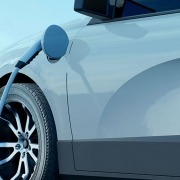The Dawn of the Sustainable Electric Vehicle Revolution
Since the first mass market electric vehicle (EV), the Nissan Leaf, was introduced a decade ago, the drumbeat has been loud and persistent about the environmental promise of the electrification of transportation. But we’ve fallen short many times despite high hopes and the best of intentions. Social forces, government policy, business priorities, and technology innovation never seemed to align.
That’s different today.
One of the strongest themes to come out of the COP26 gathering in Scotland is the urgency around the speed of technology innovation and the massive scale of deployment needed to impact climate change factors immediately and over the next several decades. Bill Gates talked about this in his notes from the conference saying: “innovation is the only way the world can cut greenhouse gas emissions from roughly 51bn tonnes per year to zero by 2050.”
This belief in the need for technology innovation (and not merely investment in R&D) deployed at scale is repeated in venture capitalist John Doerr‘s new book ‘Speed and Scale’. In this action plan for addressing climate change, the electrification of all transportation (cars, trucks, planes, and ships) is one of the main pillars with an accompanying metric of reducing the 8 gigatons of annual transportation emissions of today to 2 gigatons by 2050.
For that part of the transportation industry that is about personal vehicles, the inflection point for mass adoption of electric vehicles is gated by the intersection of driving range, charging infrastructure, vehicle design and cost – as well as individual’s changing attitudes about environmental impact and government ‘carrot and stick’ policies.
- Government Policies Span Investment and Outright Bans
Several countries in the EU have banned the sale of gas-powered vehicles by as early as 2030. In the US, President Biden’s infrastructure package prioritizes EVs ($174 billion) and the scaling of a national charging network ($15B) against the goal of bringing the nation’s emissions down to net zero by 2050.
- Auto Manufacturers’ Unprecedented Commitment to EV Sales
Less than 4% of new cars sold in the US today are EVs. But over the past year, nearly every major auto brand has made aggressive EV sales targets ranging from 50-100% for 2030 and 2035, including BMW, GM, and VW.
- EV Energy Technology Advances and Deployments Will Drive the EV Revolution
With government policies in place and manufacturers’ commitments to vehicle production and pricing, the last element needed for the EV revolution – increased vehicle driving range – rests with technology innovation and deployment in batteries and the power electronics in the onboard charger (OBC) and power inverter.
Batteries
Lithium-based batteries are one of the heaviest and most expensive items in an EV, accounting for as much as one-third of total vehicle weight. The overall weight of a vehicle impacts its driving range. Battery size needs to be balanced with the on-demand delivery of large amounts of power for the vehicle to perform to consumer expectations. The good news is that advances in battery technology have been doubling energy storage capacity every 4 years, and costs have dropped 74% since 2014.
GaN Semiconductors and Power Electronics
An EV’s onboard charger (OBC) converts AC power from the charging station into the DC power that charges the battery. The drivetrain inverter then converts that battery DC to the AC needed by the electric motor. The challenges that both OBCs and inverters have faced have been similar to those of batteries – efficiency, size, and cost. GaN System’s power transistors solve these challenges in ways that legacy silicon and IGBT (insulated-gate bipolar transistor) semiconductors cannot.
GaN Systems’ power semiconductors can increase the efficiency and decrease the size of OBC and traction inverters by 4 times in comparison to legacy silicon technology solutions. The accrued increase in overall EV efficiency and decline in weight delivers greater driving range – a 6% increase. That’s a significant number in an industry where every percentage counts in terms of consumer confidence and environmental impact.
The Road to a More Sustainable World
We are at the beginning of a game-changing revolution in the way we power our vehicles that will substantially impact the quality of our environment. The forces of government policy, consumer attitudes, auto manufacturer business goals, and the mainstreaming of technology innovation in batteries and GaN power systems have finally converged. We need to move forward with speed and scale so that the electric vehicle industry can play its important part in significantly decreasing the overall transportation industry’s gigatons of emissions to the levels needed to avoid irreparable environmental damage over the next few decades. GaN Systems is, and will be, an important part of this movement.
To learn more about how GaN Systems enables power conversion companies in every industry to revolutionize their products – from EVs and consumer devices to data centers and renewable energy systems – and transform the world, download our ebook: Creating a Sustainable World with GaN.



